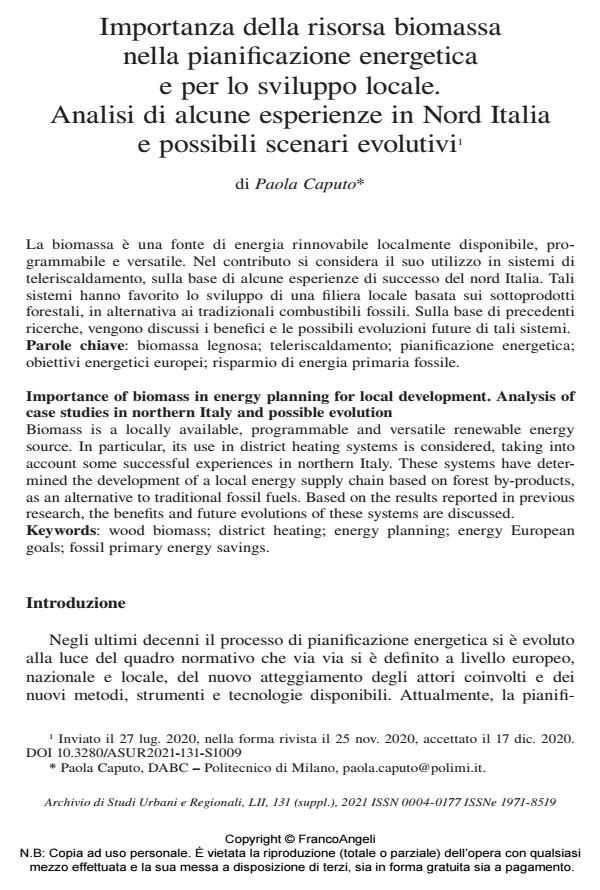Importance of biomass in energy planning for local development. Analysis of case studies in northern Italy and possible evolution
Journal title ARCHIVIO DI STUDI URBANI E REGIONALI
Author/s Paola Caputo
Publishing Year 2021 Issue 2021/suppl. 131
Language Italian Pages 19 P. 186-204 File size 149 KB
DOI 10.3280/ASUR2021-131-S1009
DOI is like a bar code for intellectual property: to have more infomation
click here
Below, you can see the article first page
If you want to buy this article in PDF format, you can do it, following the instructions to buy download credits

FrancoAngeli is member of Publishers International Linking Association, Inc (PILA), a not-for-profit association which run the CrossRef service enabling links to and from online scholarly content.
Biomass is a locally available, programmable and versatile renewable energy source. In particular, its use in district heating systems is considered, taking into account some suc-cessful experiences in northern Italy. These systems have determined the development of a local energy supply chain based on forest by-products, as an alternative to traditional fossil fuels. Based on the results reported in previous research, the benefits and future evo-lutions of these systems are discussed.
Keywords: wood biomass; district heating; energy planning; energy European goals; fossil primary energy savings.
- Aa.Vv. (2015). Biomasse legnose: Petrolio verde per il teleriscaldamento italiano. Milano: FIPER.
- Aa.Vv. (2018). Teleriscaldamento a biomassa: un investimento per il territorio. Milano: FIPER.
- Aa.Vv. (2021). Report impianti teleriscaldamento a biomassa Fiper 2020. Milano: FIPER.
- Andric I., Fournier J., Lacarriere B., Le Corre O. and Ferrao P. (2018). The impact of global warming and building renovation measures on district heating system techno-economic parameters. Energy, 150: 926-937.
- Aste N., Buzzetti M. and Caputo P. (2015). District heating in Lombardy Region (Italy): Effects of supporting mechanisms. Sustainable Cities and Society, 14: 43-55.
- Aste N., Caputo P., Del Pero C., Ferla G., Huerto Cardenas H.E., Leonforte F. (2020). A renewable energy scenario for a new low carbon settlement in northern Italy: Biomass district heating coupled with heat pump and solar photovoltaic system. Energy, 206.
- Baldan D. e Palmieri L. (2015). Linee Guida per un’economia circolare nella manutenzione del verde. Padova: Cleup.
- Beccali M., Columba P., D’Alberti V. and Franzitta, V. (2009). Assessment of bioenergy potential in Sicily: A GIS-based support methodology. Biomass and Bioenergy, 33(1): 79-87.
- Caputo P. (2010). Impianti a biomassa. Dal riscaldamento alla trigenerazione. Milano: Edizioni Ambiente.
- Caputo P. (2020). The Role of Renewable Energy Sources in Green Planning of Cities and Communities. In: Dall’O’ G., ed., Green Planning for Cities and Communities. Cham: Springer Nature, 229-251.
- Caputo P., Ferla G. and Ferrari S. (2019). Evaluation of environmental and energy effects of biomass district heating by a wide survey based on operational conditions in Italy. Energy, 174: 1210-1218.
- Caputo P., Ferla G., Belliardi M. and Cereghetti N. (2021). District thermal systems: State of the art and promising evolutive scenarios. A focus on Italy and Switzerland. Sustainable Cities and Society, 65: 102579.
- Colmenar-Santos A., Rosales-Asensio E., Borge-Diez D. and Blanes-Peiró J.J. (2016). District heating and cogeneration in the EU-28: Current situation, potential and proposed energy strategy for its generalization. Renewable and Sustainable Energy Reviews, 62: 621-639.
- Faninger G. (2000). Combined solar-biomass district heating in Austria. Sol Energy, 69: 425-35. DOI: 10.1016/S0038-092X(00)00117-
- Ferla G., Caputo P., Colaninno N. and Morello E. (2020). Urban greenery management and energy planning: A GIS-based potential evaluation of pruning by-products for energy application for the city of Milan. Renewable Energy, 160: 185-195.
- Hansen K., Breyer C. and Lund H. (2019). Status and perspectives on 100% renewable energy systems. Energy, 15: 471-480.
- Mathiesen B.V., Bertelsen N., Schneider N.C.A., García L.S., Paardekooper S., Thellufsen J.Z. and Djørup S.R. (2019). Towards a decarbonised heating and cooling sector in Europe: Unlocking the potential of energy efficiency and district energy. Aalborg: Aalborg Universitet.
- Pampuri L., Belliardi M., Bettini A., Cereghetti N., Curto I., Caputo P. (2019). A method for mapping areas potentially suitable for district heating systems. An application to Canton Ticino (Switzerland). Energy, 189: 116297.
- Reijnders L. (2006). Conditions for the sustainability of biomass-based fuel use. Energy Policy, 34(7): 863-876.
- Soltero V.M., Chacartegui R., Ortiz C., Lizana J. and Quirosa G. (2018). Biomass District Heating Systems Based on Agriculture Residues. Applied Sciences, 8(4): 476.
- Springer T.L. (2012). Biomass yield from an urban landscape. Biomass and Bioenergy, 37: 82-87.
- Stirpe F. (2009). Analisi quali-quantitativa dei residui vegetali prodotti dalla manutenzione del verde urbano di Roma. -- Testo disponibile al sito: http://dspace.unitus.it/bitstream/2067/1246/1/fstirpe_tesid.
Paola Caputo, Importanza della risorsa biomassa nella pianificazione energetica e per lo sviluppo locale. Analisi di alcune esperienze in Nord Italia e possibili scenari evolutivi in "ARCHIVIO DI STUDI URBANI E REGIONALI" suppl. 131/2021, pp 186-204, DOI: 10.3280/ASUR2021-131-S1009